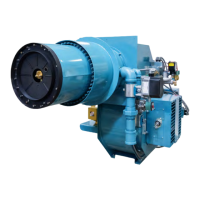Page 20
Startup and Operating Adjustments
SC Manual
1. Pre-Start Check List
Before starting the burner, a complete review of the
installation, wiring and piping of the burner, boiler and all
supporting equipment must be complete and all of these
items must be ready for operation prior to starting. The
following is a general review:
______ All wiring is connected. Gently pull on all the
wires to make sure that they are connected
properly.
______ All fuel lines are connected and tight.
______ Pilot gas is connected.
______ Burner is mounted to vessel and oor, with all
bolts secured.
______ The stack is connected and routed to the outside.
Draft controls are installed and operational, if
needed.
______ Gas vent lines are connected and routed to the
outside, if required per code.
______ Do not start the unit unless all cleanout doors are
in place and secured.
______ The vessel is completely installed, lled with
water and operating controls checked.
______ Support equipment is in place and ready (feed
pumps, draft controls, steam/hot water systems,
boiler limits and controls and feedwater systems).
______ A load must be available for the burner startup
and adjustment process. The burner must be
operated at high rates for extended periods
and the load must be able to use this energy.
______ A combustion analyzer with O
2
and CO (for gas)
must be available to tune combustion. A smoke
spot tester must be available for oil ring. A NOx
analyzer must be available. All of these analyzers
must be recently calibrated and able to provide
accurate readings.
______ Other test equipment, including manometers,
gauges and volt meter shall be available.
______ Manometer or gauge on the gas manifold.
______ Manometer or gauge before and after gas
pressure regulator.
______ Draft gauge or manometer (at stack outlet).
______ Draft gauge or manometer for furnace pressure.
2. Burner Drawer Adjustments
The burner drawer has several adjustments built into the
design that allow the combustion to be tuned. While this
can simplify the combustion tuning process, care must be
used to retain the relative position of other components
during this sequence. If these adjustments are required,
follow the sequence listed to perform the adjustments.
The burner drawer must be removed for access to
components, follow the following steps:
a. Loosen and remove the screws on the burner
drawer.
b. Disconnect the scanner by screwing it off of the
scanner tube. In some cases, the scanner simply
pulls out, with a spring tension. Secure the scanner
so that it is protected from shock.
c. Pull the drawer out, holding it centered in the
opening to prevent it from hanging up while being
pulled.
d. Set the drawer down horizontally.
To re-install the burner drawer, simply work the
procedure in reverse.
3. Gas Setup
a. Place the burner switch in the “OFF” position
b. Place the burner management system in manual
mode”. If this is a combination fuel burner, make
sure the fuel selector switch is on “GAS”.
c. Place the burner management system in the low
re position.
d. Close the downstream manual shutoff valve
(closest to the burner head) on the gas train.
e. Turn the electrical power on for the burner, boiler
and related components.
f. Verify that the gas metering valve is nearly closed,
the vent valve (if equipped) is operating and the gas
pilot valve is not open (the solenoid will hum and
feel warm).
g. Turn the burner switch on. This will start the blower
motor and initiate the prepurge cycle.
h. When the prepurge sequence is complete and the
low re start switch is made, the ame safeguard
should indicate the presence of a ame.
i. When the pilot ame is established, the ame
safeguard will energize the main gas valve
(indicated with the Fuel Valve Light). This operation
of the main fuel valves must be visually checked by
observing the valve stem operation.
j. After the timer has completed the trial for main
ame, the burner will go out on alarm (the closed
manual gas valve prevented the burner from
lighting). At this time, the gas valves must be
visually checked to verify that they have closed.
This test sequence proves the proper operation of
the primary control.
k. Press the reset button and restart the burner. When
the pilot has started, open the manual gas valve to
allow the main ame to start.
l. After a few seconds, the combustion analyzer
should have an accurate reading of the O
2
in the
stack. Fig. I-1 shows the typical range of O
2
at
different ring rates, and the burner should be
adjusted to be within this range. Rough settings for
low and mid re combustion settings are adequate
at this time. Once the high re is set, the other
settings can be ne tuned.

